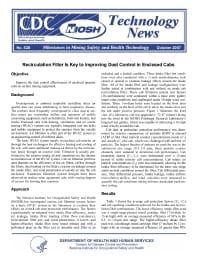Mining Publication: Technology News 528 - Recirculation Filter Is Key to Improving Dust Control in Enclosed Cabs
Original creation date: October 2007
Authors: JA Organiscak
NIOSHTIC2 Number: 20032755
Pittsburgh, PA: U.S. Department of Health and Human Services, Public Health Service, Centers for Disease Control and Prevention, National Institute for Occupational Safety and Health, DHHS (NIOSH) Publication No. 2008-100. Technology News 528, 2007 Oct; :1-2
Overexposure to airborne respirable crystalline silica (or quartz) dust can cause debilitating or fatal respiratory disease. The workers most frequently overexposed to silica dust at surface mines are overburden drillers and operators of mobile excavating equipment, such as bulldozers, front-end loaders, and trucks. Enclosed cabs with heating, ventilation, and air conditioning (HVAC) systems are typically integrated into the drills and mobile equipment to protect the operator from the outside environment. Air filtration is often part of the HVAC system as an engineering control of airborne dusts. The basic HVAC system mainly recirculates cab interior air through the heat exchangers for effective heating and cooling of the cab, with some additional makeup air drawn by the recirculation fan(s) through an exterior inlet. Filtration is usually performed on the exterior intake air and sometimes on the interior recirculation air of the HVAC system. Cab air filtration performance depends on the efficiency of the air filters, airflow through the filters, dust loading on the filters, exterior air leakage around the intake filter, and wind penetration of outside air into the cab enclosure. Numerous filtration system designs have been observed on surface mine equipment cabs with varying degrees of success for limiting dust exposure.

NIOSHTIC2 Number: 20032755
Pittsburgh, PA: U.S. Department of Health and Human Services, Public Health Service, Centers for Disease Control and Prevention, National Institute for Occupational Safety and Health, DHHS (NIOSH) Publication No. 2008-100. Technology News 528, 2007 Oct; :1-2